encouragement - See praise.
engaged column - In architecture, a column-like, nonfunctional form projecting from a wall and articulating it visually.
Also see pilaster.
engobe - A colored slip used in decorating ceramics. They have several distinctive attributes, but are also excellent alternatives to glazes because they are less expensive and less time consuming. Engobes are typically made by mixing water with a claybody in use, then mixing in one or more colorants (e.g. oxides) — in a proportion of dry ingredients to water that is about 1:2 by volume. They are best applied in a consistency like cream to leatherhard greenware, or a little thinner when applied to bisque. Colored slips stay put — they won't run or blur as many glazes do. Textures made in colored slip will remain as they're formed, instead of smoothing out as do those made with glazes. They can be applied with a brush, a slip-trailing bottle, or by dipping or spraying. Another method for using engobes in making a design is called sgraffito: coat unfired clay with engobe, and then scratch away at parts of it to reveal the clay surface underneath.
(pr. en-gohb)

enlargement - A larger version of an image or of a work. Making an enlargement is sometimes called a bump up or a blowup.
Example:

Titian (Tiziano Vecellio) and Workshop, Venus and the Lute Player, c. 1565-70,
oil on canvas,
65 x 82 1/2 inches (165.1 x 209.6 cm), Metropolitan Museum of
Art, NY. (On the Met's page, you can enlarge
any detail.)
Among the most reknowned enlargements of the 20th century were paintings by Georgia O'Keefe:
Georgia O'Keeffe (American, 1887-1986), Yellow Jonquils # 3, 1936, oil on canvas, 30 1/4 x 40 1/4 inches, Kemper Museum of Contemporary Art, Kansas City, MO. See nature.
Georgia O'Keefe, Pink Shell with Seaweed, c. 1937, 22 x 28 inches, pastel on paper, San Diego Museum of Art, CA. See volute.
Also see aliased and anti-aliased, close-up, detail, panorama, telephoto, wide-angle lens, and wide-angle shot.
Enlightenment - Also called the Age of Reason, the name applied to an intellectual movement and zeitgeist which developed in western Europe during the seventeenth century and reached its height in the eighteenth. The common element was a trust in human reason as adequate to solve the crucial problems and to establish the essential norms in life, together with the belief that the application of reason was rapidly dissipating the darkness of superstition, prejudice, and barbarity, was freeing humanity from its earlier reliance on mere authority and unexamined tradition, and had opened the prospect of progress toward a life in this world of universal peace and happiness. In the visual arts, this was the time of the Baroque period.
An image of the Enlightenment:
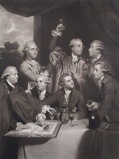
William Say (English engraver, 1768-1834),
after a painting by Sir Joshua Reynolds (English, 1723-1792),
Sir
William Hamilton and Society Dilettante, c. 1780s, mezzotint, 25 1/2 x 18 1/2 inches.
This is a gathering of the members of the Society Dilettante, an exclusive club of British aristocrats dedicated to studying classical art and knowledge on the Grand Tour and as a pastime. As the men enjoy a drink together, Sir William Hamilton (1730-1806), a prominent collector, shows them one of his ancient Greek and Roman vases and a recently published book of engravings of his vase collection. The members are, left to right: Sir W.W. Wynn, Sir J. Taylor, Mr. Payne Galway, Sir William Hamilton, Mr. Richard Thompson, Mr. Stanhope, and Mr. Smith of Heath.
Born to an aristocratic Scottish family, Sir William Hamilton was an enthusiast of the arts and sciences at the height of the Age of Enlightenment. He assembled one of the world's finest collections of Greek and Roman antiquities as British Envoy Extraordinaire to the two Sicilies from 1764-1800. Most of the antiquities he collected came from excavations in Italy, and he later sold most of them to the British Museum. The glories of his vase collection were recorded in portfolios, which served as souvenirs for the great libraries of Grand Tour travelers and patrons, and provided inspiration to decorative art designers in England, such as Josiah Wedgwood (1730-1795). See dilettante.
Quote:
Also see Buddhism, ideal, idealism, inspiration, and knowledge.
ennui - Boredom; listlessness and dissatisfaction resulting from lack of interest and motivation, resulting in lack of effort.
(pr. ah-nwee)
Walter Sickert chose Ennui as the title of his painting:

Walter Richard Sickert (English, 1860-1942),
Ennui, c. 1914, oil
on canvas, 152.4 x 112.4 cm,
Tate Gallery, London. See aestheticism
and English art.
Also see existentialism and expression.
entablature - In architecture,
the upper section of a classical
building. Resting on the columns,
it consists first of the architrave,
the frieze, and the cornice
on top.
Examples:
Entablatures as they figure into a diagram of the Doric order and a diagram of the Ionic order.
Also see abacus, capital, classical orders, Corinthian, Doric, echinus, Greek art, Ionic, metope, orders, Roman art, shaft, stylobate, and triglyph.
entartete - See degenerate and fascist aesthetic.
entasis - An almost imperceptible convex tapering (an apparent swelling) in the shaft of a column.
(pr. en-TAH-səs)
entertainment - Art which is at least amusing.
Quote:
Also see cinema, dance, kitsch, popular culture, superficial, and theater.
enthusiasm - Great excitement for or interest in a subject or effort, or the source or cause of such great excitement or interest. An enthusiast is an enthusiastic person. Enthusiasm is an important ingredient in motivation to produce art, as well as to study and enjoy it in other ways. It is a quality that springs from the personality of artists, teachers and other lovers of art. Instructors develop their students' enthusiasm most effectively by demonstrating it. So much of school life is routine and mundane that teachers and students can slip into a business-as usual rut. But enthusiasm in the classroom is the spice that brings new zest to learning for teachers as well as for students.
Some strategies for educators:
Also see achievement, art criticism, attention, bias, critique, effort, goals, interesting, posterity, praise, and success.
entropy - The tendency of all matter and energy in the universe — including all systems, societies, etc. — to change toward a state of disorder or randomness. The works of earth artists — Robert Smithson (American, 1938-1973), for example — reflect an interest in the concept of entropy. Related to this is the use of the term in information theory, where entropy is a measure of the apparent disorder of a system, so that the more there is known about it, the less entropy it seems to have. In this vein, entropy is understood as the number of possibilities, which decreases as knowledge grows.
(pr. EN-troh-pee)
Also see chaos, composition, interdisciplinary, and order.
epistemology - The branch of philosophy that studies the nature of knowledge, its extent and validity. An epistemological question might be "How can we really know that . . . ?"
(pr. ə-PISS-tə-MAH-lə-jee)
Also see appreciate, art criticism, art history, cognitive, critique, discover, empiricism, genius, gestalt, interdisciplinary, liberal arts, memory, metaphysics, mind, ontology, perception, phenomenology, science and art, sense, and teleology.
epistle - A message or letter; in the New Testament, any of the letters written by apostles.
(pr. ə-PISS-əl)
epistyle - See architrave.
(pr. e"pi-sti:l')
epitome - An example of a class or type; a representative or typical example. This does not mean the best example, but rather one which is typical of what's available. Art educators, limited in the number and variety of examples of art images they can show to students, seek exemplars along with pieces which epitomize their types.
(pr. ə-PIT-ə-mee)
Also see archetype and avatar.
epoxy resin - A thermosetting plastic resin, used for resin casting. Epoxins are also used in the manufacture of adhesives which bond firmly.
trademarks for epoxins
|
trade name |
manufacturer, country |
| Araldite ® | CIBA Geigy, UK |
| Durax ® | Axel Plastics, USA |
| Epocast ® | Furane Plastics, USA |
épreuve d'artiste - French for artist's proof, abbreviated E.A.
EPS - Encapsulated PostScript. An electronic image-storage format that extends the PostScript page description language to include images.
Also see digital image.
épure - In architecture, a full-scale, detailed drawing done on a wall, floor, or other large surface, from which are traced the patterns for various building elements.
(ay-PYOOR)
equestrian statue and equestrian art
equilateral - When every side of a polygon is of the same length. A square, for instance, must be equilateral in order to be a square.
(pr. EE-kwə-LA-tə-rəl)
Also see mathematics, regular, and shape.
equilibrium - A state of rest or balance between contrasting elements or opposing forces.
(pr. EE-kwə-LI-bree-əm)
Also see dominance, emphasis, and weight.
equine art or equine statue - An image or a sculpture of a horse, with or without a rider. A sculpture of a horse with a rider can more specifically be called an equestrian statue.
(pr. EH-kwi:n)
Examples of equine art:

Greece, Geometric type, probably made in Sparta about 700 BCE, said to be from Phigaleia (Bassae) in Arcadia, Greece, Figurine of a Horse, bronze, height 4 inches, British Museum, London.

Egypt, Prancing Horse, c. 1391-1353 BCE,
late Dynasty 18, probably reign of Amenhotep IV, New Kingdom,
stained ivory, garnet
inlay, length
6 inches (15 cm), Metropolitan Museum of Art, NY. See Egyptian art.

Attributed to Han Gan (Chinese, active 742-756),
Night-Shining White, T'ang
dynasty, 8th century CE,
ink on paper,
12 1/8 x 13 3/8 inches (30.8 x 34 cm), Metropolitan Museum of
Art, NY. This is one of the most revered horse paintings in Chinese art. This
short scroll displays
a formidable provenance in
the form of chops of its
former owners. See Chinese
art.
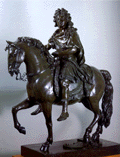
Francois Girardon (French, 1628-1715), Model for the Equestrian Statue of Louis XIV,
bronze, Hermitage Museum, St. Petersburg,
Russia. See model.

George Stubbs (English, 1724-1806), Horse Attacked by a Lion, 1769, enamel on copper,
24.1 x 28.3 cm, Tate Gallery, London. See Romanticism.

John Ferneley I (English, 1782-1860), Mr. Powell and his Son, with Norton, a Grey Hunter,
1816, oil on canvas,
86.0 x 107.6 cm, Tate Gallery, London.

John Ferneley I, Defiance, a Brood Mare, with Reveller, a Foal,
1833, oil on canvas,
71.2 x 94.0 cm, Tate Gallery, London.

John Frederick Herring (English, 1795-1865),
Stable Scene, oil
on canvas, 45.4 x 70.8 cm,
Tate Gallery, London.

Eadweard Muybridge (American, born in England,
1830-1904), Jumping a hurdle; saddle; bay horse Daisy
Plate 640 of Animal Locomotion, 1887, collotype,
Worcester Art Museum, MA. See animation,
cinema, movement, and time.

Raymond Duchamp-Villon (French, 1876-1918),
The Large Horse, 1914 / 1976, bronze,
150 x 97 x 153 cm, Georges Pompidou Center, Paris. See Cubism.
Related site:
equipoise - An equal distribution of weight, relationship, or forces.
(pr. EH-kwə-poyz)
Also see counterpoise and balance.
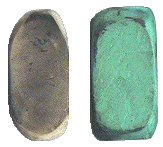 eraser - A tool used in the erasure
of parts of drawings. Graphite
pencil drawings are erased
with any of several types of rubber. (It was after this use that
the substance called
eraser - A tool used in the erasure
of parts of drawings. Graphite
pencil drawings are erased
with any of several types of rubber. (It was after this use that
the substance called  rubber
received its name.) Lighter parts of charcoal
drawings can be erased with either a kneaded
eraser (also called putty rubber) or a kneaded piece of fresh
bread. Wax crayons
and lithographic crayons cannot
be erased unless they are on non-absorbent
surfaces.
rubber
received its name.) Lighter parts of charcoal
drawings can be erased with either a kneaded
eraser (also called putty rubber) or a kneaded piece of fresh
bread. Wax crayons
and lithographic crayons cannot
be erased unless they are on non-absorbent
surfaces.
(ə-RAY-sər or ee-RAY-sər)
Also see canvas scraper, clean up, palimpsest, solvent, and stain removal.
erasure - Removal, usually of written or drawn marks by erasing — rubbing, blotting, wiping, or scraping. The goal of erasure is typically to remove all traces of something, although one finds it practical to compromise at partial erasure. And, the scrambling of material recorded magnetically, as in the use of the delete key on a keyboard.
Erasure is a subtractive  gesture.
gesture.
Additive gestures that obscure place material above the surface to be altered. Also see coat, collage, cover, decollage, distort.
To redact is to conceal (text) from a document prior to its publication or release. Redacting is usually accomplished by covering sensitive areas with opaque pigment, or by removing these areas with scissors or knife. Here's an example: F.B.I. Director Robert S. Mueller met with Attorney General John Ashcroft on March 12, 2004, to ask if Ashcroft would approve a controversial domestic spying program for US President George W. Bush. Later, Mueller wrote some notes about the meeting. Months later, when these notes were to be published, they were extensively redacted. A photo of that document.
(pr. ə-RAY-shər)
Also see camouflage, clean up, eraser, implied, palimpsest, solvent, and stain removal.
ergonomics - An applied science concerned with the characteristics of people that need to be considered in the design of devices and systems in order that people and things will interact effectively and safely. This is also called human engineering or human-factors engineering. Some objects occasionally cited as ergonomically well designed are: the umbrella, the bicycle, the pencil, and the Post-it note. In furniture, it's the Freedom Chair by Niels Diffrient (American, contemporary).
Also see anatomy, ASTM International (American Society for Testing and Materials), humanism, human scale, interdisciplinary, interdisciplinary, safety, and science and art.
erotica and erotic art - Erotica includes images, books, and objects that cause or celebrate sexual feelings or desires. Just as "beauty is in the eye of the beholder," some observers will perceive erotica as obscene or pornographic. But when sexually suggestive or explicit materials are deemed erotica or erotic art, they are described more neutrally or positively than they are when called obscenity or pornography.
Either way, such subject matter is typically deemed inappropriate for students who are younger than those at the college level.
Examples:
![]()

![]()
Roman, Love Scene, mosaic,
Piazza Armerina, Sicily.
![]()

![]()
French(?), Scoop, c. late 20th century.
Also see aidoion, beauty, censorship, fig leaf, feminism and feminist art, First Amendment rights, gender issues, love, nude, odalisque, sensuality, sybaritic, and voyeurism.
ersatz - Describes an artificial and inferior substitute or imitation. An adjective drawn from a German noun meaning "substitute," Ersatz was first prominently borrowed by English speakers during World Wars I and II, when it was frequently applied as an adjective to food products made in immitation of the real thing — such as a coffee made from acorns, a flour made from potatoes, or a sugar made from sawdust.
(pr. AYR-sahts or AYR-zahts)
Also see allusion, analogy, appropriation, copy, copyright, counterfeit, derived image, facsimile, fake, forgery, kitsch, likeness, mirror, paint-by-number, plagiarism, replica, representation, reproduction, simile, simulacrum, and simulation.
escutcheon - In heraldry, a shield or a shield-shaped emblem bearing a coat of arms. Also, an ornamental or protective plate, as for a keyhole or a push-button.
(pr. ə-SKUT-chən)
eshi - In Japanese art tradition, a painter.
esquisse - A sketch showing the general features of a design or plan.
Also see architecture.
esthetics - See aesthetics.
etch - To use acid to cut into a surface, usually metal or glass. Too often confused with engrave.
See etching.
ethnic - Relating to sizable social groups sharing a common and distinctive racial, national, religious, linguistic, or cultural heritage. "Ethnic" was once a term for Egyptian, African, Mesoamerican, and other non-Christian ("heathen") peoples, even though European cultures posess all the exoticism, inscrutability and "otherness" that "ethnic" implies. European, like ethnic arts, are the products of specific times and places, beliefs and taboos, produced to serve ritual ends, religious and social, confer prestige, and provide cultural self-affirmation. Also similarly, European art evokes complex, sometimes conflicting reactions, admiration, bafflement, amusement, and disdain. "Ethnic" (like "primitive") should therefore be used very cautiously. Considering how profoundly we have needed to reevaluate our uses of "ethnic" to designate non-European peoples, a contemporary use is likely to smack of negative stereotype and ethnocentrism.
Also see Aboriginal art, American Indian art, anthropocentrism, Buddhist art, Chicano art / Chicana art, Chinese art, folk art, Harlem Renaissance, heritage, Hindu art, Islamic art, Jewish art, Mexican art, Russian art, tradition, xenophilia, and xenophobia.
ethnocentrism - The tendency to see one's own ethnic group as the norm and all others as marginal; a form of racism.
Quote:
Also see Afrocentrism, Eurocentrism, feminism and feminist art, gender issues, isms and -ism, issue, multiculturalism, stereotype, ugly, xenophilia, and xenophobia.
ethnosphere - The web of human culture around our planet. This word was coined in the late 1990s by an ethno-biologist as a counterpart to "biosphere," which stands for the web of living organisms inhabiting earth. Prediction: next will be geosphere — from geology. Jockosphere? Dweebosphere?! Sphereosphere?!
Also see civilization, custom, ethnocentrism, material culture, multiculturalism, tradition, and xenophilia.
ethyl alcohol - See alcohol.
Etruria - See Etruscan art.
Eurocentrism - The tendency to see European culture and history as the norm and all others as marginal. See also art history, ethnic, ethnocentrism, isms and -ism, lookism, and xenophobia.
eurythmy - Harmony of proportion or movement. Among the principles of design, eurythmy is a hybrid of three of the principles — harmony, proportion, and movement.
Also see composition, distort, elongate, emphasis, Golden Mean, music, rhythm, and scale.
eutaxia, eutaxic - See taxis.
evaluation - The ability to judge the value of material (work of art, statement, writing, music, etc.) for a given purpose. Evaluation represents the sixth level of learning outcomes in the cognitive domain — the level of understanding just beyond analysis and synthesis. Intelligent judgments must be based upon definite criteria. These may be internal (organization) or external criteria (relevant to the purpose) and the student may determine the criteria or be given them. Objectives of lessons which will increase a student's ability to evaluate can be stated with such behavioral terms as: accept, adjudge, appraise, arbitrate, assay, assess, award, classify, conclude, criticize, critique, decide, decree, describe, determine, discriminate, estimate, evaluate, explain, grade, interpret, judge, justify, measure, predict, prioritize, rank, rate, referee, reject, rule on, select, settle, summarize, support, umpire, and weigh. Some have proposed that there is one higher thinking skill: meta-cognition.
Also see achievement, assessment, Bloom's Taxonomy, description, effort, and interesting.
Evangelists - The four writers of the Gospels in the New Testament: Matthew, Mark, Luke, and John. Frequently, they are represented in works of art by their conventional symbols: an angel, a lion, an ox, and an eagle.
examination - The study and recording of the physical characteristics of an object. Also see assessment, condition, description, and Praxis.
excavate - To dig a hole into something or to hollow it out by digging or scooping. Or, to expose or uncover by digging, as in the pursuit of archaeology. The act or process of excavating is called excavation.
exemplar - Something that serves as an example; typical or representative of its type; especially an example that is worthy of imitation; a model or ideal. As opposed to an exemplum, an exemplar can be both an ideal model as well as one in a range of examples in a group. Art educators, limited in the number and variety of examples of art images they can show to students, seek exemplars along with pieces which are epitome of their types.
Also see archetype, avatar, and realia.
exemplum - Something that serves as an example; typical or representative of its type. As opposed to an exemplar, an exemplum is not so much an ideal model as it is simply one in a range of examples of a type.
Also see archetype and realia.
exergue - A space on the reverse of a coin or medal, usually below the central design and often giving the date and place of its production.
(pr. ek-sərg or EGG-zərg)
Also see die and numismatics.
exhibit and exhibition - A public showing of a piece or a collection of objects.
Other resources concerning exhibit and exhibition:
Also see alternative spaces, American Watercolor Society (AWS), bin, curator, emerging artist, frame, gallery, Kunstkabinette, Kunstkammer, motivation, museum, opening, preparator, special exhibition, vernissage, Wunderkabinette, Wunderkammer, and vitrine.
existentialism - An anti-rationalist philosophical tendency and attitude to life concerned with the being or existence of the free individual in an absurd or meaningless universe. Existentialism has had many variants, but its most prominent spokesmen have been Søren Kierkegaard (Danish, 1813-1855) and Jean-Paul Sartre (French, 1905-1980).
An example of work influenced by existentialism:
Alberto Giacometti (Swiss, 1901-1966), The Nose, 1947, plaster on metal, suspended by synthetic string within a metal structure, 81.5 x 66 x 36.7 cm, Centre Georges Pompidou, Paris. Alberto Giacometti was a Surrealist and a friend of Sartre's. See angst.
Also see angst, Dada, isms and -ism, motivation, and Surrealism.
ex libris - See bookplate.
exonumia - A branch of numismatics that includes medals, tokens, and scrip. Although exonumia does not include conventional coins and paper currencies, money with various unusual qualities might be included — elongated or encased coins for instance. [What about credit cards? Is that a collection of exonumia in my wallet?! - MRD]
Related resources:
Also see counterfeit, ephemera, philately, and scripophily.
exothermic - A material which gives off heat as it cures is described as exothermic.
Also see temperature.
expanded polystyrene plastic - A plastic having a light-weight, granular mass, usually worked in sheets or blocks, but also available in loose granules. A trademark often used for expanded polystyrene plastic is Styrofoam (often mentioned in print as [lower-case s] styrofoam).
Also see foam core.
expression and expressionism - (with a small e — the more general sense) An attitude conveyed by the set of a person's facial features. Also, a quality of inner experience, the emotions of the artist (expressive qualities) communicated through emphasis and distortion, which can be found in works of art of any period. See a larger article devoted exclusivly to expression and expressionism, which includes examples of expressionist works, quotations, etc.
Examples of expression in the first sense:
Charles Lebrun (French, 1619-1690), Expressions of the Spirit's Passions: Anger, c. 1663, head three-quarters to the right, black pencil, (width 25 cm), Louvre. See Baroque and Poussinisme.
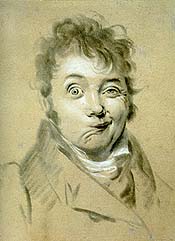
Léopold Boilly (French, 1761-1845),
Grimacing Man (Self-Portrait), c. 1822-23, conté
crayons on paper, collection of
Karen B. Cohen. See caricature,
Neoclassicism,
and self-portrait.
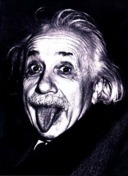
American, Albert
Einstein, photograph.

Kenjji Marshall (American, contemporary),
a face in Marshall's comic book Eden, 2000, published
by Sigma6, Detroit, MI.
Quote:
Also see angst, bias, choose, dance, emotionalism, Expressionism, fanciful, frisson, irony, isms and -ism, love, motivation, nuance, oneiric, pain, portrait, sentiment, Surrealism, and Symbolism.
Expressionism - (with an upper-case E — the more specific sense) An art movement dominant in Germany from 1905-1925, especially Die Brücke and Der Blaue Reiter, which are usually referred to as German Expressionism, anticipated by Francisco de Goya y Lucientes (Spanish, 1746-1828), Vincent van Gogh (Dutch, 1853-1890), Paul Gauguin (French, 1848-1903) and others. See an article devoted exclusivly to Expressionism, which includes examples of Expressionist works, quotations, etc.
Also see isms and -ism.
expressive qualities - The feelings, moods, and ideas communicated to the viewer through a work of art. This aesthetic quality is favored by emotionalism.
Quote:
Also see empathy, expressionism and Expressionism, and interpretation.
exquisite - Showing intricate and beautiful design or execution, and so beautiful or delicate as to arouse delight. Also, acutely perceptive or discriminating. Sometimes used to refer to a person who is excessively fastidious in appearance, manners, or taste.
Also see aesthetics and connoisseur.
exquisite corpse or cadavre exquis - Aleatoric techniques for producing either visual or literary art devised by surrealists in which several people collaborate in creating a text or an image. This activity is often called a game, and the product of this activity are also called an exquisite corpse or, in the original French, cadavre exquis. This game is based upon an old parlor game in which players take turns writing on a sheet of paper folded it to conceal part of the writing, and then pass it to the next player for another contribution.
The surrealists' version of the game acquired its name from the results of the first use of the technique. This was a sentence in French: "Le cadavre exquis boira le vin nouveau," meaning "the exquisite corpse will drink the young wine." The first works were sentences, and were first produced in the mid-1920s. Later literary works were typically poetry. These bizarre compositions were explained by Nicolas Calas as revealing the "unconscious reality in the personality of the group."
Surrealism was embraced by practicioners of many arts, and so it was inevitable that visual artists would take it up, first to produce drawings and collages. The first such efforts, reminiscent of children's books that allow the making of pictures with multiple pages divided at various levels, involved assigning a section of a body to each player. Most resulted in images that only vaguely resembled the human form. Some of the participants in early exquisite corpses were Yves Tanguy (French, 1900-1955), Joan Miró (Spanish, 1893-1983), and Man Ray (American, 1890-1977). Later adaptations have involved using other means of passing the work around, such as sending it through the mail; or using other media, resulting in sculpture, film, digital, etc.
(pr. cadavre exquis as kə-DAH-vrə əks-KEE)
Examples:
An exquisite corpse drawing by Yves Tanguy, Man Ray, Max Morise, Joan Miró, c. 1926.

André Breton (French, 1896-1966), Valentine Hugo (French, 1890-1968), Greta Knutson and Tristan Tzara (French, born Romania. 1896-1963), Landscape, c. 1933, colored chalk on black paper, 9 1/2 x 12 1/2 inches (24.1 x 31.7 cm), Museum of Modern Art, NY.
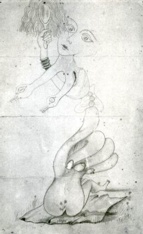
Victor Brauner (Romanian, 1903-1966), André Breton (French, 1896-1966), Jacques Hérold (Romanian, 1910-1991), Jeannette Tanguy and Yves Tanguy. (American, born France. 1900-1955), Figure, 1934, pencil on paper, 10 1/8 x 6 1/2 inches (25.6 x 16.5 cm), Museum of Modern Art, NY.
An exquisite corpse drawing by Victor Brauner, André Breton, Jacques Hérold and Yves Tanguy, 1935. Another by them.
Related resources:
Also see Fluxus, game theory, and incongruity.
extended loan - An object loaned to a museum for long-term, sometimes indefinite use. Naturally, museums hope that an extended loan will eventually become a part of its permanent collection.
Also see deed of gift and donation.
extender and extending - Material used to increase the bulk of a medium; the act of adding such a material. Often used in less expensive (sometimes sold as "student quality") paints. Sometimes called filler and filling.
Also see aggregate.
exterior - Something that is outside. For example, in architecture, an exterior wall is on the outside of a building.
Also see elevation.
extrados - The upper and / or outer surfaces of arches and vaults.
(pr. ek-STRAH-dohs)
Also see intrados.
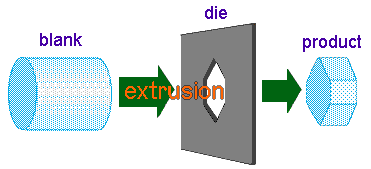
extrude, extrusion - To extrude is to form the shape of an object by forcing plastic media (a "blank") such as clay, wax, plaster, or dough through a die. Extrusion is the process of forming three-dimensional shapes in this way; or it is any product of this process. 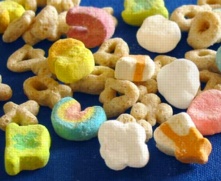
Some pipes, tubes, and other objects are manufactured by extrusion, as are such culinary products as certain breakfast cereals (Lucky Charms®), pastas, cookies, and candies. Bakery workers often decorate cakes by extrusion — squeezing or "piping" frosting from conical bags with variously shaped openings at their tips.
 Hasbro's "Fun Factory" is a tool for extruding Play-Doh® through strips of plastic dies. Play-Doh is a modeling compound with similar physical properties to clay, but it is not actually ceramic.
Hasbro's "Fun Factory" is a tool for extruding Play-Doh® through strips of plastic dies. Play-Doh is a modeling compound with similar physical properties to clay, but it is not actually ceramic.
![]() Once a pug mill has mixed water with dry clay, it extrudes the product through a round or square opening. Viewers are apt to compare such extrusion to excretion. (Such observers may be indiscrete [infantile?!], diverting attention from loftier goals, but excrement is a product ubiquitous to creatures with digestive systems.) One crucial
Once a pug mill has mixed water with dry clay, it extrudes the product through a round or square opening. Viewers are apt to compare such extrusion to excretion. (Such observers may be indiscrete [infantile?!], diverting attention from loftier goals, but excrement is a product ubiquitous to creatures with digestive systems.) One crucial  difference between these processes is the greater potential in extrusion for varying the shape of the product.
difference between these processes is the greater potential in extrusion for varying the shape of the product.
Here's a large machine (an extruder) that is extruding a gray plastic.
Although wire is formed by pulling ever-thinner strands of metal through dies, this action is typically termed drawing rather than extruding.
More liquid media — paint, glaze, and slip — can be applied by forcing it through small holes, using a squirt bottle, syringe, or spraying device perhaps, but its formation is unlikely to be termed extrusion. A resulting mark — dot, line, wash, mist, whether ![]()
 dragged or smoothed across a surface — will be largely two-dimensional.
dragged or smoothed across a surface — will be largely two-dimensional.
Also see hot glue gun, mold, and set.
ex voto or ex-voto - A votive offering, typically an object presented at shrines, sometimes pinned to images of saints, etc. Latin for "out of thankfulness."
Also see charm, iconoduly, and milagro.

eyedropper - A tool often used in the mixing and
application of small and precise
amounts of liquids, such as dyes.
An eyedropper can be useful in floating oil
colors on  water
in the marbling of paper.
Eyedroppers are very inexpensive, and can be readily obtained
from phamacies — called chemists in many countries. Glass eye
droppers are generally preferable to plastic ones unless safety
is an issue.
water
in the marbling of paper.
Eyedroppers are very inexpensive, and can be readily obtained
from phamacies — called chemists in many countries. Glass eye
droppers are generally preferable to plastic ones unless safety
is an issue.
In manipulating digital images, an eyedropper tool is used to sample a color that needs to be referenced. Typically a color look-up table (CLUT) will show you which color you have selected, and how it relates to other colors in the the palette.
Also see marbling, solvent, stain, stain removal, and water-soluble.
eye-hand coordination - Movement of the hand as directed by the eye and brain.
Also see direction, representation, and sight.
https://inform.quest/_art